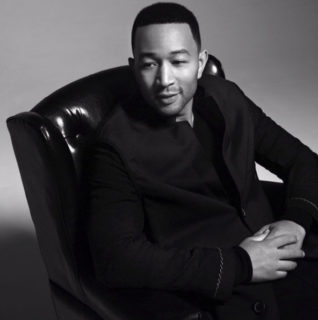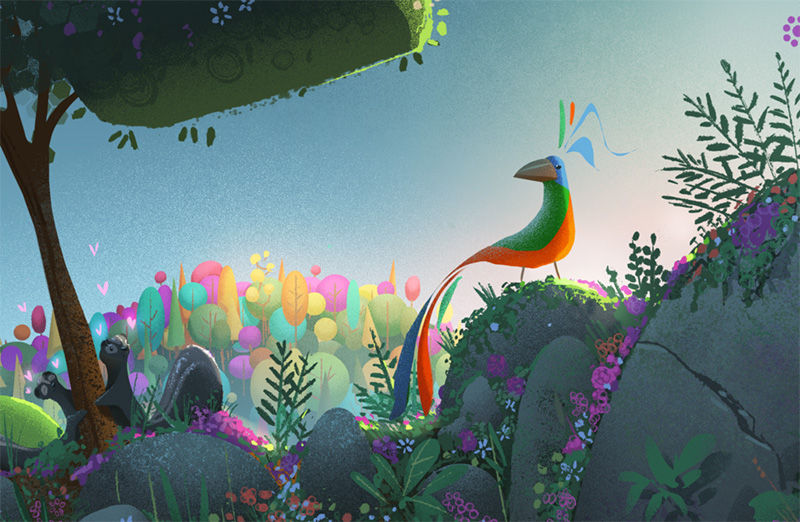Baobab Studios has been on a roll since debuting its VR short, Invasion! at the Tribeca Film Festival last year. In just a short time, the company raised $25 million in funding from multiple investors, debuted Asteroids! (the sequel to Invasion!), and it is now ready to premiere the first episode of its latest project, Rainbow Crow, at the Tribeca Film Festival this week.
Rainbow Crow is a multi-chapter narrative based on a Native American myth involving a beautiful multicolored bird with a mellifluous singing voice who embarks on an adventure to save the world and its creatures—a friendly but excitable skunk in particular—from freezing in a long winter. The VR experience features the voice of singer John Legend, who plays the title character and is also a producer for the series.
The series is currently in production with a launch on all major VR platforms expected later this year. Similar to Asteroids!, viewers will be able to interact with the experience, such as shaking a pair of branches using touch controllers to add snow flurries to a scene.
Baobab CEO, Maureen Fan, and chief creative officer and studio co-founder, Eric Darnell (who also directed the Madagascar movies), sat down with AListDaily to talk about how Rainbow Crow came together and how John Legend became involved. The two also go in-depth on how they’re treating VR as a new storytelling medium and why celebrities seem to be so attracted to it.

How has Baobab been evolving its content?
Fan: Following the success of Invasion!, we premiered Asteroids! at the Sundance Film Festival. Asteroids! takes place in the same universe as Invasion! and stars Elizabeth Banks. Invasion! is one of the top VR experiences across all platforms. Back when it launched, people thought that VR was just about hardcore games, and it was surprising to everyone that our piece shot to the top. We discovered that narrative VR is something that people want, and not just that, but specifically things that are lighthearted and comedic. Rainbow Crow is somewhat comedic, but it’s more dramatic than Invasion!, however it still proves that people want narrative experiences in VR.
The important thing about Invasion! was because it was the first time we made you a character in VR. You were a bunny and nobody had done that before. Now everyone is trying to do that. The second thing that Eric figured out how to do was to direct the viewer’s eyes using another bunny. When she looked to the right, you look there too to see what she’s looking at.
But the big thing we learned from Invasion! was how much people loved that bunny. People tried to pet her, and they waved at her and tried to play with her because they were sure that she was real. In film, you don’t really believe a person is real when they break the fourth wall and look at you. But in VR, you believe that things are there with you. So, with Asteroids! we wanted to take that feeling of caring and turn it into action. Now you can use controllers and help the characters and do tasks. Asteroids! is about Mac and Cheese, the two aliens from Invasion!, and you’re aboard their spaceship. You’re a menial task robot, and your job is to help them and earn their approval.
We like to say that if a little girl was crying on a park bench in a film, you’d feel bad for her but do nothing. If it’s in a game, you’d go talk to her, but you’re doing it to get information to reach the next level. If it’s in real life, you would probably talk to her because you care about her. Our creative vision is to get the empathy of films with the agency of games but the motivation of real life, where you interact with these characters because you care about them. We think VR allows you to do what no other medium allows: care about those characters more than in film or television.
How would you describe Rainbow Crow?
Darnell: The background is based on a Lenni Lenape Tribe Native American legend. The story has been passed down orally for generations. So, we’ve taken this story, which is the origin story about why crows are the way they are today, and expanded on it by adding detail and depth that digs deeper into some of the thematic components and makes things more contemporary for modern audiences. It’s almost like a storybook that you can imagine someone telling around the campfire, so we’re approaching it like a storybook with chapters.
John is very excited about it, and one of the reasons he wanted to do it was because of the themes of self-sacrifice, giving back, bringing light to darkness and self-acceptance.

How did John Legend become involved?
Fan: In general, Eric is very pure. He doesn’t do things based off how much of a celebrity someone is. So, we come up with a list of people, and he closes his eyes while we play YouTube videos. Then he figures out which voice sounds most like the character he’s envisioning. John Legend was one of the voices Eric really liked, so we approached him, and he has apparently been looking into the VR industry for quite some time. He has been approached by many people, but he specifically loved the themes in Rainbow Crow. John is a huge social activist, so it’s always important for him to always be giving back to the community. He’s interested in VR because it’s another platform for him to share his values with people. He’s an artist—a singer—but he was also an actor and an executive producer for La La Land. It was just a perfect match for us.
It’s been amazing that we’ve been able to attract so much star power. Usually, it’s Hollywood putting their stuff into new technologies. But these artists are doing it because they’re so creatively excited by this medium. We’re really honored because they have so many people they can choose to work with, and they’ve chosen us because we’re similarly minded. John isn’t just a voice, he’s creatively involved and he has helped us come up with ideas. But it’s also from a business perspective in terms of our relationships, our distributors and the success of Invasion!
Why make Rainbow Crow an episodic series instead of another short?
Fan: It’s about length. All of our episodes will be between five to twelve minutes long, and we do this because we know that people don’t necessarily want to be in the headsets for extended periods of time. We’re going to have a minimum of three episodes, and it’s a matter of figuring out where the natural breaking points are. Then people can decide whether they want to binge watch them all or experience them in short chunks. Right now, what’s important is experimenting, and working with shorter chunks allows us to experiment more.
Darnell: This is a magical story that exists outside of reality. Perhaps it will remind you of some of the storybooks you read as a kid. We were thinking about what it would be like if you could step into a page from your favorite storybook. We’re thinking of it like a book with chapters, and thinking of the world as one that’s not trying to be photoreal—but it will feel real because it’s virtual reality. [Chapters] are also part of the experimentation. If people are leaning into a moment, thematic component, or character—that’s great for us to know. Then we can look at our chapters down the road and think about how we can leverage off the things people are responding positively to.
Ethan Hawke is a voice in Invasion!, Elizabeth Banks is in Asteroids! and now John Legend is in Rainbow Crow. Are you surprised that so many celebrities want to be involved in VR?
Fan: I think it makes sense. It doesn’t necessarily make sense for studios to get deeply involved yet, because VR is still experimental and they don’t know if it will ever monetize. So, it makes sense that they use VR more as a marketing budget for other things. But actors and actresses are creatively minded. They want to do what is exciting to them. So, it’s no surprise that VR is exciting to them, because it’s magic. For John, he doesn’t just get to be a part of it, he gets to drive it.
What audience are you targeting with your VR projects?
Fan: Definitely families. We were told that one of the reasons that Invasion! took off is because most VR caters to a very specific audience with hardcore games or documentaries about Syria. Samsung told us that one of the reasons they liked using us as their main demo was because it brought delight and smiles to everybody’s faces, from children to grandmas. When you can do a story very well, audiences will like it. Rainbow Crow is more dramatic than Invasion!, so it may be more appealing to certain audiences. We’re going after VR enthusiasts while hoping that we’ll bring more audiences to the medium.
Darnell: It was very encouraging for us because when we came out, most of the audience was early adopters. In the sea of games and more mature content—or at least content that was targeted for adults—we were able to leap to the top of the charts with our cute little bunny. That meant that there were a lot of twenty-something-year-old gamers who were responding to our stuff. If we can have a great story and tell it well with characters that people can connect with, then I think that opens up a broad audience for us. That includes children, grandparents, teens, adults and anybody who is excited about VR.

